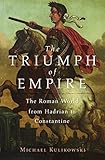The triumph of empire : the Roman world from Hadrian to Constantine / Michael Kulikowski.
Material type: TextPublication details: Cambridge, Massachusetts : Harvard University Press, (c)2016.Edition: First Harvard University Press editionDescription: 1 online resource (xxv, 360 pages, 16 unnumbered leaves of plates ) : illustrations, maps, platesContent type:
TextPublication details: Cambridge, Massachusetts : Harvard University Press, (c)2016.Edition: First Harvard University Press editionDescription: 1 online resource (xxv, 360 pages, 16 unnumbered leaves of plates ) : illustrations, maps, platesContent type: - text
- computer
- online resource
- 9780674974227
- DG270 .T758 2016
- COPYRIGHT NOT covered - Click this link to request copyright permission: https://lib.ciu.edu/copyright-request-form
| Item type | Current library | Collection | Call number | URL | Status | Date due | Barcode | |
|---|---|---|---|---|---|---|---|---|
 Online Book (LOGIN USING YOUR MY CIU LOGIN AND PASSWORD)
Online Book (LOGIN USING YOUR MY CIU LOGIN AND PASSWORD)
|
G. Allen Fleece Library ONLINE | Non-fiction | DG270 (Browse shelf(Opens below)) | Link to resource | Available | ocn962753150 |
"First published as Imperial Triumph: The Roman World from Hadrian to Constantine in the United Kingdom in 2016 by Profile Books Ltd."--Title page verso.
Includes bibliographies and index.
The Triumph of Empire takes readers into the political heart of imperial Rome and recounts the extraordinary challenges overcome by a flourishing empire. Michael Kulikowski's history begins with the reign of Hadrian, who visited the farthest reaches of his domain and created stable frontiers, to the decades after Constantine the Great, who overhauled the government, introduced a new state religion, and founded a second Rome. Factionalism and intrigue sapped the empire from within, even at its apex. Roman politics could resemble a blood sport: rivals resorted to assassination; emperors rose and fell with bewildering speed, their reigns measured in weeks, not years; and imperial succession was never entirely assured. Canny emperors--including Marcus Aurelius, Septimius Severus, and Diocletian--constantly cultivated the aristocracy's favor to maintain a grip on power. Despite such volatility, the Roman Empire protected its borders, defeating successive attacks from Goths and Germans, Persians and Parthians. Yet external threats persisted and the imperial government sagged under its own administrative weight. Religion, too, was in flux with the rise of Christianity and other forms of monotheism. In the fourth century CE, Constantine and his heirs reformed imperial institutions by separating civilian and military hierarchies, restructuring the government of both provinces and cities, and ensuring the prominence of Christianity. The Triumph of Empire is a fresh, authoritative narrative of Rome at its height and of its evolution--from being the central power of the Mediterranean world to becoming one of several great Eurasian civilizations.--
The early years of Hadrian -- The late reign and the succession -- Peace and war at mid-century -- The last of the Antonines -- Septimius Severus and his rivals -- The reign of Severus -- The later Severans -- Eurasian history and the Roman Empire -- From Gordian III to Valerian -- Valerian and the generals -- The last of the soldier emperors -- Diocletian, Constantine and the creation of the -- Later Roman Empire -- The failure of the tetrarchy -- Constantine and Licinius -- The structure of empire before and after Constantine -- The Constantinian empire -- The children of Constantine -- Constantius, Julian and the empire to come -- The Roman emperors from Augustus to Julian -- Persian kings from Ardashir to Shapur II.
COPYRIGHT NOT covered - Click this link to request copyright permission:
There are no comments on this title.
